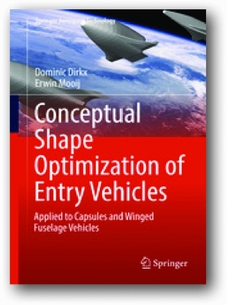
The re-entry vehicle preliminary design phase is an important phase of the design process, the aim of which is to narrow down possible solutions and define an optimum configuration of the re-entry vehicle without time-consuming solutions being examined in detail that have fundamental flaws.
The targeting audience of this book are the readers who have an extensive background in the area of aerodynamics and aerothermodynamics and want to familiarise themselves with the process of optimisation.
The book consists of nine chapters and two appendices. The spread of the information and the level of complexity vary a lot between the chapters. The book starts with a brief introduction into the re-entry concepts of the 20th and the 21st centuries (Section 1.1, Chapter 1) and, in Section 1.2, already plunges into shape optimisation. In this section, the authors juggle with the concepts and definitions of the subject area as well as provide results, implying the reader to have a certain level of technical expertise in the area of optimisation.
The authors then move to Chapters 2–6 where they provide an extremely brief overview of the vehicle stability, entry equations and aerodynamic forces. Throughout these chapters, numerous cross-referencing is given, which seems to be far too excessive. In some cases, reference to the earlier pages generates a certain level of confusion as, instead of the expected information, the referencing page contains a back-reference.
Some of the information provided by the authors is not communicated in a clear way. The authors need to decide the level of importance of viscosity, which in some sections is mentioned to be an important parameter and in some sections is mentioned to play a minor role. Sometimes, the authors operate with the equations but give an explanation or a definition of the used values much later in the book. The sections in the book seem to be somehow mixed up. For example, according to Section 3.6, the method selection depends on the geometry, i.e. parametrisation, of the re-entry vehicle. Section 3.6 references Section 5.3 where the geometry is defined. It is not clear why it was not possible to introduce the method selection section after the parametrisation of the vehicles.
The last five chapters represent Pareto charts, Monte-Carlo analysis and the results of the optimisation process. There is only little information with regards to the connection between the basic information given in the first half of the book and the results presented in the last chapters. This connection is presented in the form of the description of the simulation code, which is rather specific.
Nevertheless, the book is a useful source of information for the readers working in the area of optimisation; however, the fundamentals are covered more comprehensively in other texts.


